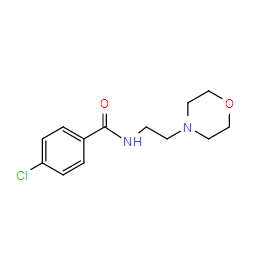| References: |
Moclobemide belongs to a new generation of short-acting, reversible, monoamine oxidase (MAO) inhibitors. In vitro (rat brain homogenates) moclobemide inhibits MAO-A selectively with lower potency than many of the reference MAO inhibitors. However, when measured ex vivo in the rat, the potency of moclobemide is similar to that of reference compounds. In vivo the drug induces a dose-dependent, short-lasting (8-16 hr) and preferential inhibition of MAO-A in the brain and both MAO-A and MAO-B inhibition in extracerebral organs (liver, small intestine and kidney). In the extracerebral tissues of the rat moclobemide induces marked peripheral MAO-B inhibition due to rapid and extensive biotransformation of its morpholine ring. The active molecular species is probably the metabolite Ro 16-6491. The moderate MAO-B inhibition measured after moclobemide intake in human platelets indicates that only minor amounts of Ro 16-6491 are formed in humans. Virtually all metabolites of moclobemide so far identified have been tested in vitro and ex vivo in the rat and proved to be either equipotent or, mostly, less effective than moclobemide as MAO-A inhibitors. In liver homogenates of moclobemide-treated rats MAO-A activity recovers during dialysis or simple incubation at 37 degrees C, suggesting a biodegradation of moclobemide and/or the moclobemide-derived active metabolite(s) by MAO itself or a slow dissociation of the active inhibitory species from the enzyme. Similar to other MAO-A inhibitors, moclobemide induces an increase in the rat brain levels of 5-hydroxytryptamine, norepinephrine and dopamine and a concomitant decrease of their deaminated metabolites. These effects are of short duration (8-16 hr) and parallel the time course of MAO-A inhibition. Moclobemide administered subchronically down-regulates beta adrenoceptors as shown by binding experiments with brain cortical membranes using dihydroalprenolol as ligand. In vitro MAO inhibition by moclobemide is specific in that the compound does not affect other amine oxidases or monoamine uptake mechanisms; furthermore, it does not interact with various neurotransmitter or drug receptor sites. In conclusion, a large body of preclinical evidence characterizes moclobemide as a short-acting and reversible MAO-inhibitor. The neurochemical profile of moclobemide indicates clearly that this nonhydrazine nonhepatotoxic MAO-A inhibitor represents a novel and safe drug for treatment of affective disorders.
Moclobemide is a reversible inhibitor of monoamine-oxidase-A (RIMA) and has been extensively evaluated in the treatment of a wide spectrum of depressive disorders and less extensively studied in anxiety disorders. Nearly all meta-analyses and most comparative studies indicated that in the acute management of depression this drug is more efficacious than placebo and as efficacious as tricyclic (or some heterocyclic) antidepressants or selective serotonin reuptake inhibitors (SSRIs). There is a growing evidence that moclobemide is not inferior to other antidepressants in the treatment of subtypes of depression, such as dysthymia, endogenous (unipolar and bipolar), reactive, atypical, agitated, and retarded depression as with other antidepressants limited evidence suggests that moclobemide has consistent long-term efficacy. However, more controlled studies addressing this issue are needed. For patients with bipolar depression the risk of developing mania seems to be not higher with moclobemide than with other antidepressants. The effective therapeutic dose range for moclobemide in most acute phase trials was 300 to 600 mg, divided in 2 to 3 doses. While one controlled trial and one long-term open-label study found moclobemide to be efficacious in social phobia, three controlled trials subsequently revealed either no effect or less robust effects with the tendency of higher doses (600 - 900 mg/d) to be more efficacious. Two comparative trials demonstrated moclobemide to be as efficacious as fluoxetine or clomipramine in patients suffering from panic disorder. Placebo-controlled trials in this indication are, however, still lacking. A relationship between the plasma concentration of moclobemide and its therapeutic efficacy is not apparent but a positive correlation with adverse events has been found. Dizziness, nausea and insomnia occurred more frequently on moclobemide than on placebo. Due to negligible anticholinergic and antihistaminic actions, moclobemide has been better tolerated than tri- or heterocyclic antidepressants. Gastrointestinal side effects and, especially, sexual dysfunction were much less frequent with moclobemide than with SSRIs. Unlike irreversible MAO-inhibitors, moclobemide has a negligible propensity to induce hypertensive crisis after ingestion of tyramine-rich food ("cheese-reaction"). Therefore, dietary restrictions are not as strict. However, with moclobemide doses above 900 mg/d the risk of interaction with ingested tyramine might become clinically relevant. After multiple dosing the oral bioavailability of moclobemide reaches almost 100%. At therapeutic doses, moclobemide lacks significant negative effects on psychomotor performance, cognitive function or cardiovascular system. Due to the relative freedom from these side effects, moclobemide is particularly attractive in the treatment of elderly patients. Moclobemide is a substrate of CYP2C19. Although it acts as an inhibitor of CYP1A2, CYP2C19, and CYP2D6, relatively few clinically important drug interactions involving moclobemide have been reported. It is relatively safe even in overdose. The drug has a short plasma elimination half-life that allows switching to an alternative agent within 24 h. Since it is well tolerated, therapeutic doses can often be reached rapidly upon onset of treatment. Steady-state plasma levels are reached approximately at one week following dose adjustment. Patients with renal dysfunction require no dose reduction in contrast to patients with severe hepatic impairment. Cases of refractory depression might improve with a combination of moclobemide with other antidepressants, such as clomipramine or a SSRI. Since this combination has rarely been associated with a potentially lethal serotonin syndrome, it requires lower entry doses, a slower dose titration and a more careful monitoring of patients. Combination therapy with moclobemide and other serotonergic agents, or opioids, should be undertaken with caution, although no serious adverse events have been published with therapeutic doses of moclobemide to date For the detailed information of Moclobemide, the solubility of Moclobemide in water, the solubility of Moclobemide in DMSO, the solubility of Moclobemide in PBS buffer, the animal experiment (test) of Moclobemide, the cell expriment (test) of Moclobemide, the in vivo, in vitro and clinical trial test of Moclobemide, the EC50, IC50,and affinity,of Moclobemide, For the detailed information of Moclobemide, the solubility of Moclobemide in water, the solubility of Moclobemide in DMSO, the solubility of Moclobemide in PBS buffer, the animal experiment (test) of Moclobemide, the cell expriment (test) of Moclobemide, the in vivo, in vitro and clinical trial test of Moclobemide, the EC50, IC50,and affinity,of Moclobemide, Please contact DC Chemicals. |























